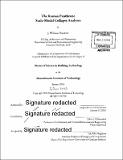The Roman Pantheon : scale-model collapse analyses
Author(s)
Plunkett, J. William (James William, Jr.)
DownloadFull printable version (2.858Mb)
Other Contributors
Massachusetts Institute of Technology. Department of Architecture.
Advisor
John A. Ochsendorf.
Terms of use
Metadata
Show full item recordAbstract
The Roman Pantheon is among the largest unreinforced masonry dome ever built and is an unparalleled example of the construction capabilities of the ancient Romans. As one of the most well-known buildings in the world, its preservation remains important because of its cultural and societal significance, and the methods used to assess the safety of historic masonry structures continue to be developed, particularly for three-dimensional vaulted forms. Through a study of the Roman Pantheon, this thesis compares analytical and experimental results on a 1:100 scale model of the variable thickness, hemispherical dome. The model is created using additive manufacturing for accuracy. This thesis, using a physical scale model, quantifies the safety of the Roman Pantheon against the two most probable causes of collapse (i) deformation of the building geometry and (2) seismic activity. The structural behavior of the model is compared to analytical predictions of (1) spreading supports, simulating leaning walls that result from the dome thrust or settling of the foundations, and (2) tilting, a first-order approximation of horizontal ground acceleration. The experimental tests lead to the formation of a mechanism and collapse due to instability. High-speed imagery captures the observed collapse mechanisms and failure limits. Experimental results are compared to analytical predictions for hemispherical masonry domes. The results of the physical experiment demonstrate the potential for digitally fabricated scale models in approximating the behavior of three-dimensional structures with complex geometries. The low cost and rapid approach provides a useful method for validating analytical predictions of the limit states and collapse mechanisms of unreinforced masonry structures.
Description
Thesis: S.M. in Building Technology, Massachusetts Institute of Technology, Department of Architecture, 2016. Cataloged from PDF version of thesis. Includes bibliographical references (pages 27-31).
Date issued
2016Department
Massachusetts Institute of Technology. Department of ArchitecturePublisher
Massachusetts Institute of Technology
Keywords
Architecture.